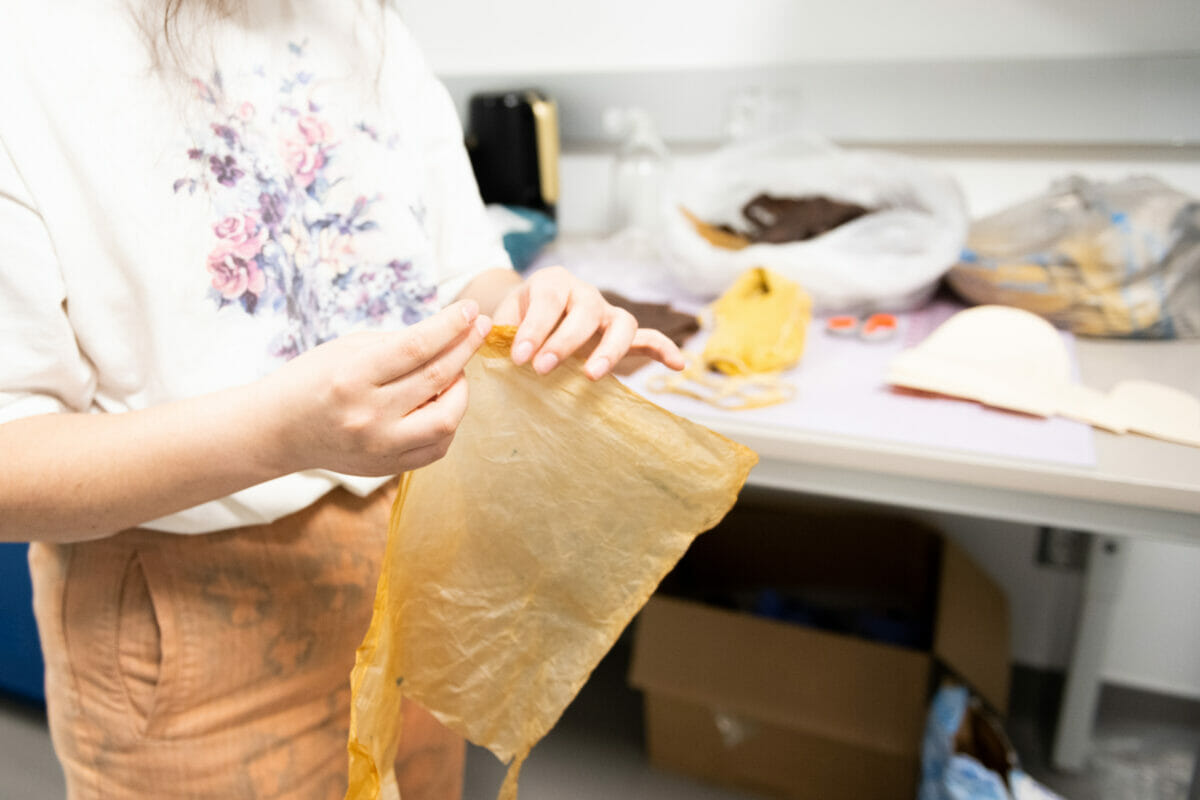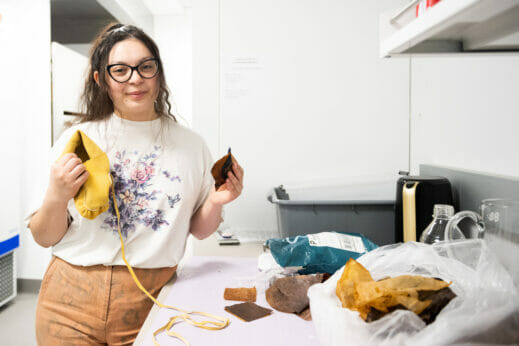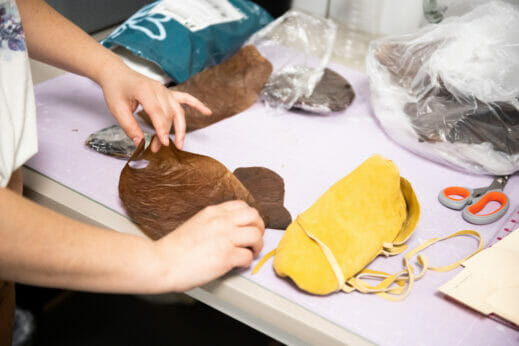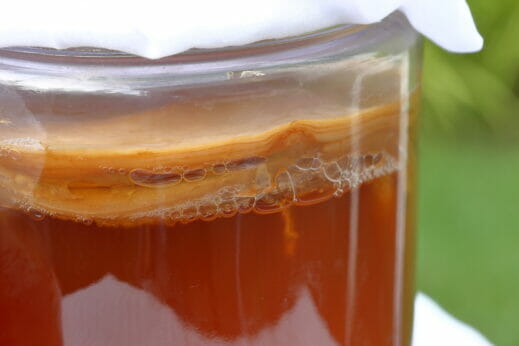Does the Future of Textiles Include Fermented Fashion?
Researchers and entrepreneurs consider kombucha and fermented biopolymers as a sustainable source material for clothing, car interiors and more.
Does the Future of Textiles Include Fermented Fashion?
Researchers and entrepreneurs consider kombucha and fermented biopolymers as a sustainable source material for clothing, car interiors and more.

Asiah Brazil-Geyshick holds a textile she made from kombucha SCOBY. by University of Idaho.
Kombucha is widely consumed as a fermented, effervescent tea. But some people in the world of textiles look at kombucha and see something else. Asiah Brazil-Geyshick, an Ojibwe student studying apparel, textiles and design at the University of Idaho, saw a pair of moccasins, a medicine bag and a wallet, all of which she hand-stitched from dried kombucha SCOBY, a symbiotic culture of bacteria and yeast.
Alternative textiles aren’t new, but the use of sustainable materials in the industry, while still a small percentage overall, is growing. In an attempt to combat the unsustainable consumption of clothing and other materials made from synthetic fibers, scientists and entrepreneurs have considered other more environmentally friendly alternatives, such as algae and mycelium.
Kombucha tea is made from tea, sugar and a SCOBY. The SCOBY takes the shape of a gelatinous mat, and when it’s dried out and shaped, it can resemble leather or fabric.
SCOBY has its advantages as a material since it’s environmentally sustainable to produce and also biodegradable at the end of its life. But it also has drawbacks. For example, it sponges up water in a way you don’t want clothing to do. Still, with a little bit of experimentation, Brazil-Geyshick made several items out of this material. In the future of sustainable textiles, can kombucha become a prominent player?

Homegrown
Chelsey Byrd Lewallen teaches an introduction to textiles class at the University of Idaho. In the class, she covers non-traditional textiles, such as coconut, orange peel and more.
Byrd Lewallen brought up the prospect of kombucha leather in her class, along with the idea of partnering with a local company, Love’s Kombucha, to try and make a usable leather alternative out of SCOBY. Her student, Brazil-Geyshick, was inspired and volunteered to take on the project.
“I got excited because I’m Native American, and we use a lot of leather,” says Brazil-Geyshick.
Byrd Lewallen and Brazil-Geyshick began doing research, gathering materials and learning from others who had experimented with this material.
After mixing the materials and growing the SCOBY, Brazil-Geyshick took the thick and rubbery mats—“It feels like raw chicken,” she says—and washed them in soapy water. This removed the fermentation smell and some of the stickiness. After washing, she dried and rubbed them with glycerin.

It was a lot of trial and error—some things worked really well, such as rubbing glycerin into the SCOBY to prevent it from becoming too brittle, a tip they picked up from Armine Ghalachyan at Washington State University, who is well versed in working with kombucha. Other things were less successful, like when they had the wrong proportion of sugar in their recipe, causing the material to fall apart.
Once the material was made, dyed, dried and ready to work with, Brazil-Geyshick began creating.
“It’s really fun to do your own natural stuff,” says Brazil-Geyshick.
The material is not waterproof, Byrd Lewallen and Brazil-Geyshick say, but they’re still optimistic that it can be useful with additional experimentation and that it can be part of a wave of sustainable materials that will help shift the needle away from fast fashion and its hefty environmental impact.
“I think we [as a society] can do better,” says Byrd Lewallen. “I know we can do better.”
Beyond the SCOBY
Byrd Lewallen and Brazil-Geyshick are far from the only ones experimenting with kombucha as a textile. Fashion designer Suzanne Lee, who founded Biocouture and Biofabricate, brought the potential for kombucha textiles into the public eye. Scientist Theanne Schiros partnered with the brand Public School to style a fashionable sneaker using SCOBY. Today, there is a handful of companies and researchers experimenting with the raw material or specific elements derived from or inspired by it and creating usable textiles.

Zimri T. Hinshaw, founder and CEO of Bucha Bio, began growing kombucha under his roommate’s bed for use in textile development. But, over time, he realized that, for his purposes, he didn’t actually want the SCOBY itself but a byproduct of fermentation called bacterial nanocellulose.
“It imbues things with immense tensile strength,” says Hinshaw. So, now, Bucha Bio uses bacterial nanocellulose as a raw ingredient to make its composite products stronger. The company no longer brews kombucha, but it sources the bacterial nanocellulose from a larger producer of fermented products.
SCOBY as a textile can be brittle to work with and vulnerable to water, which is why Hinshaw chose to change paths and instead use an isolated element that would give his products—usable in everything from car interiors to clothes—strength without the SCOBY-associated drawbacks.
“If it reabsorbs water in, say, a rainstorm … on your skin, that’s gonna feel pretty gross,” says Hinshaw.
Bucha Bio’s composite materials are also made from bio-based resins and additives, as well as pigments from fruit and algae. The strength added by the bacterial nanocellulose is a significant boon for functionality.
According to Hinshaw, the interest in sustainable materials in the textile industry is tangible, but the path is not yet paved.
“In terms of the startups, there’s not been one clear winner,” says Hinshaw. “We haven’t had our Impossible Foods or our Beyond Meat yet. So, the potential is any one of these number of startups could be that.”
Hinshaw’s advice for consumers is to consider their buying power and do research to find materials that are holistically sustainable.
“Try to buy something made out of next-gen materials, rather than another recycled PET [polyethylene terephthalate] material like another recycled shoe,” says Hinshaw. “That’s great, but it’s not the future.”
Follow us

This work is licensed under a Creative Commons Attribution-NoDerivatives 4.0 International License.
Want to republish a Modern Farmer story?
We are happy for Modern Farmer stories to be shared, and encourage you to republish our articles for your audience. When doing so, we ask that you follow these guidelines:
Please credit us and our writers
For the author byline, please use “Author Name, Modern Farmer.” At the top of our stories, if on the web, please include this text and link: “This story was originally published by Modern Farmer.”
Please make sure to include a link back to either our home page or the article URL.
At the bottom of the story, please include the following text:
“Modern Farmer is a nonprofit initiative dedicated to raising awareness and catalyzing action at the intersection of food, agriculture, and society. Read more at <link>Modern Farmer</link>.”
Use our widget
We’d like to be able to track our stories, so we ask that if you republish our content, you do so using our widget (located on the left hand side of the article). The HTML code has a built-in tracker that tells us the data and domain where the story was published, as well as view counts.
Check the image requirements
It’s your responsibility to confirm you're licensed to republish images in our articles. Some images, such as those from commercial providers, don't allow their images to be republished without permission or payment. Copyright terms are generally listed in the image caption and attribution. You are welcome to omit our images or substitute with your own. Charts and interactive graphics follow the same rules.
Don’t change too much. Or, ask us first.
Articles must be republished in their entirety. It’s okay to change references to time (“today” to “yesterday”) or location (“Iowa City, IA” to “here”). But please keep everything else the same.
If you feel strongly that a more material edit needs to be made, get in touch with us at [email protected]. We’re happy to discuss it with the original author, but we must have prior approval for changes before publication.
Special cases
Extracts. You may run the first few lines or paragraphs of the article and then say: “Read the full article at Modern Farmer” with a link back to the original article.
Quotes. You may quote authors provided you include a link back to the article URL.
Translations. These require writer approval. To inquire about translation of a Modern Farmer article, contact us at [email protected]
Signed consent / copyright release forms. These are not required, provided you are following these guidelines.
Print. Articles can be republished in print under these same rules, with the exception that you do not need to include the links.
Tag us
When sharing the story on social media, please tag us using the following: - Twitter (@ModFarm) - Facebook (@ModernFarmerMedia) - Instagram (@modfarm)
Use our content respectfully
Modern Farmer is a nonprofit and as such we share our content for free and in good faith in order to reach new audiences. Respectfully,
No selling ads against our stories. It’s okay to put our stories on pages with ads.
Don’t republish our material wholesale, or automatically; you need to select stories to be republished individually.
You have no rights to sell, license, syndicate, or otherwise represent yourself as the authorized owner of our material to any third parties. This means that you cannot actively publish or submit our work for syndication to third party platforms or apps like Apple News or Google News. We understand that publishers cannot fully control when certain third parties automatically summarize or crawl content from publishers’ own sites.
Keep in touch
We want to hear from you if you love Modern Farmer content, have a collaboration idea, or anything else to share. As a nonprofit outlet, we work in service of our community and are always open to comments, feedback, and ideas. Contact us at [email protected].by Lena Beck, Modern Farmer
September 12, 2023
Modern Farmer Weekly
Solutions Hub
Innovations, ideas and inspiration. Actionable solutions for a resilient food system.
ExploreShare With Us
We want to hear from Modern Farmer readers who have thoughtful commentary, actionable solutions, or helpful ideas to share.
SubmitNecessary cookies are absolutely essential for the website to function properly. This category only includes cookies that ensures basic functionalities and security features of the website. These cookies do not store any personal information.
Any cookies that may not be particularly necessary for the website to function and are used specifically to collect user personal data via analytics, ads, other embedded contents are termed as non-necessary cookies.